1-23-10
Himalaya and With a Girl of Black Soil: Jeon Soo-il and the Rhythms of Life
By Diane Sippl
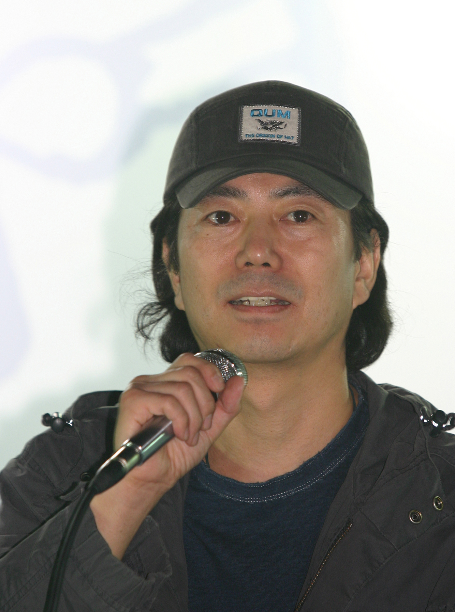
“There’s a French poem someone told me that inspires me a lot…‘The ruins of a city are beautiful, but the ruins of humanity are truly breathtaking.’ I feel eager to swim deeply into the human psyche to discover such beautiful ruins and expose them to others.”
Writer-director-producer Jeon Soo-il
On January 15, 16, 17, and 24,
the UCLA Film & Television Archive screens a six-film retrospective of the
work of the internationally esteemed Jeon Soo-il, a series presented by the
Ciné-Asie Film Institute of Montreal that travels to three Canadian cities and
three American cities through April, 2010.
In the last thirteen years South Korean film director, film producer,
and screenwriter Jeon Soo-il has made seven feature films, all of them winning
awards at festivals from Pusan to Venice, from the Canary Islands to France and Switzerland,
from Karlovy Vary to Moscow and Teheran. After studying film directing in Pusan and then France,
Jeon Soo-il completed his master’s and doctorate degrees in Film Science at the
Paris Diderot
University and is currently Associate
Professor of the Department of Theatre and Film at Kyungsung University
and the President of Dongnyuk Films production company.
A strong proponent of Korean independent cinema today, Jeon makes films that are far from the familiar genres and styles many associate with the nation’s output of popular entertainment; in fact, his films are being introduced to most North American audiences for the first time. They include: I Came from Busan, 2009; Himalaya, Where the Wind Dwells, 2008; With a Girl of Black Soil, 2007; Time between Dog and Wolf, 2005; My Right to Ravage Myself, 2003; The Bird Who Stops in the Air, 1999; and Wind Echoing in My Being, 1997.
Cinema has always been regarded in some circles as profaning the arts, but in Jeon Soo-il’s hands, it’s like turning the wheel of Dharma. Frame by frame, we can read his inscriptions of compassion as we spin their shadows through the projector’s lantern, hoping to glean new light. His characters search for it in their journeys, ranging from a man’s pilgrimage for purification to a girl’s quest for sustenance and family renewal. A prayer wheel is a tangible visual aid for taming, opening, and developing the mind, energizing the heart. What more ubiquitous way of turning it than through the art of cinema?
In Himalaya, Where the Wind Dwells, Mani wheels rattle in a Nepalese home while at the monastery, mantra spin with a tinny vibration to the chant of lonesome hymns. A father has died working in faraway Korea, and a stranger arrives to deliver his ashes, a mission that becomes increasingly difficult as he comes to know the man’s family.
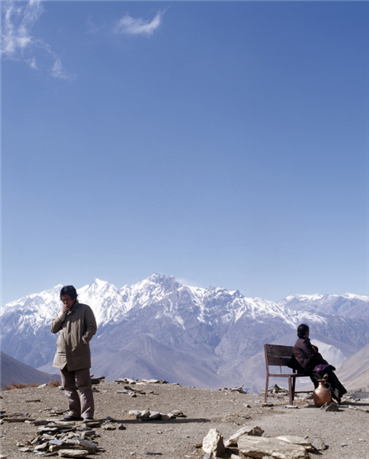
Himalaya, Where the Wind Dwells
Back in the collapsing rubble of South Korea’s northern Kangwon province, in With a Girl of Black Soil, little Young-lim is left to care for her father, a dejected miner laid off for his black lung disease, and her developmentally disabled brother. As we are reminded in viewing Time Between Dog and Wolf, these are not stories shot straight as an arrow. There paths can be circuitous, their characters lost; but the sense of time and space Jeon creates on the screen is unforgettable.
It’s a marvel the way Jeon Soo-il
builds texture into his shots, layers of graphic tension with each composition
of shape, color, and light. The
deliberate lack of resolution within each frame calls for the next one yet carries
a tone in the emotional flow of the film.
Opting for miniscule dialogue and the mere hint of a narrative thread,
he brings us the tactile images and resonant sounds of real locations, both
geographic and psychic, creating an experience that is direct and immediate. Often shunning continuity editing for an
overall layering of scenes like verses in a song, he crafts characters who
shift or shatter upon losing their homes, villages, jobs, loved ones but
nonetheless strive to pick themselves up, collect themselves, and connect. His films sometimes feel like documentary
portraits built of a succession of cinematic tableaux, animated by the to-and-fro
movement of a child hopping or milling about, a business man trekking or a
village man swinging a khor, a black
dog moseying down a lonely road — or is it a wolf?
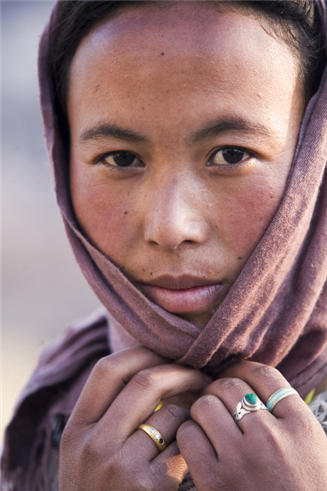
Himalaya, Where the Wind Dwells
Diane Sippl I think everybody must find your films visually striking, but first I want to ask you about something even more surprising, and that’s the aural aspect — the use of music, of ambient sound, and of dialogue — everything that we hear.
Jeon Soo-il I prefer films with little dialogue. I want to tell the story as visually as possible. So while creating an image, I try to create sounds — not sound effects per se, but sounds that would strengthen the image and bring it more to life. Even in my use of music, I like it to feel not so much like music but to have the feeling of a sound.
DS What is the very low musical sound in Himalaya and Time between Dog and Wolf? It seems to be one or maybe two strings strummed for a very low twang, a deep vibrating sound.
JS It’s the contra-bass. The first time I demanded the use of this instrument, and the second time, I demanded another instrument, the piano, but played in the minor key and used just for counterpoint.
DS It works very well, especially in Time between Dog and Wolf, because with just the one string and the one piano key played at a time, we feel the abstraction of these two lone, individual characters.
It seems sometimes you use diegetic music, or source music, rather than a score, but often even that music comes from just outside the frame. Sometimes we see it performed, but then it’s usually a song, or maybe the flute, as in Himalaya. What are your thoughts about music? When and why do we need to see where it comes from?
JS First of all, I generally don’t like to use music in a film as a score. Second, I don’t like to let music overpower the expression of the characters or to dramatize the emotions; I like them to arrive without any interference. When I work with the composer I ask him to look at the scene, at the images, and imagine the inner psyche and the feelings of the character, not necessarily through melody, but through sounds.
DS You
use a lot of songs; you show people singing them. I don’t mean what we hear on the radio or
any music overheard from the night club.
They seem to be folk songs in Himalaya and even in Time Between. Where do they
come from? Are they old songs? Are they written for the film? Or are they just poetic lyrics?
JS For example in Himalaya, the local people of Sharkot are singing prayers. And in this region they sing these folk songs every day. It’s not at all unusual. In Time Between, when the woman in the bar is singing, it’s a popular song; but in the car, with the harmonica, it’s an old Korean folk song about the separation of the family. Also, when the main character is drunk and he’s driving, he sings an old-fashioned Korean song.
DS Do
you collect these?
JS Just those about the lost families, and about reunions.
DS I bring this up because your films seem so quiet, and yet they are filled with songs — either this kind, old songs, or in Time Between, lots of newer popular songs. So they’re not really quiet films. They’re filled with songs, and they’re filled with sounds. It might be animal sounds — moo or baah, or dogs barking.
JS And the animal sounds might not be clear, you might not be conscious of them.
DS Yes, but also, in a way, they stand out — in a good way. And I’ll tell you why: because they expand the frame of what we look at, so we’re thinking of a much bigger picture than the one we see on the screen. For example, we hear a baby cry, but we don’t see the baby; and we hear the crying because we hear sounds of a couple making love, but we don’t see the love-making.
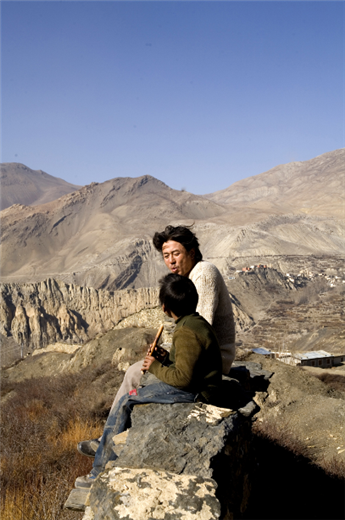
Himalaya, Where the Wind Dwells
We don’t see the source of any of the sounds, but they come from just beyond the frame of the shot, so don’t they open the frame? Somehow we feel the whole valley, or the whole town, or all the families, or maybe even more families not in that village. We feel them all.
So your films are hardly silent, yet with all these sounds, you let us feel the solitude. It’s the way you put sound and image together. It might feel quiet because nobody’s moving, or because the camera is often still. And maybe the character, the actor, is quite pensive. But the sound is very alive, and because of this, we feel the loneliness or solitude.
JS I like the camera held up on the shoulder, so it’s a little shaky. I want to create the feeling that our main character has uncertain emotions. When I go location hunting, normally I get the rhythm of the music and the special sounds of the location.
DS So I think there’s a rhythm between your sound and image, and not just within your sounds, and not just with your camera fixed or moving. For example, what is that object the old man holds that he swings around and around? It makes a rhythm — not just the clicking sound, but the visual swinging of the ball.
JS It’s a kind of prayer instrument. And also outdoors you hear the prayer wheels being turned, where Buddhist prayers are written; one turn of the wheel is one verse from the Buddhist Bible offered in the prayer ritual. You see the prayer wheels surrounding the temple and also at the entrances to each of the villages; in this culture you turn it as a wish for well being.
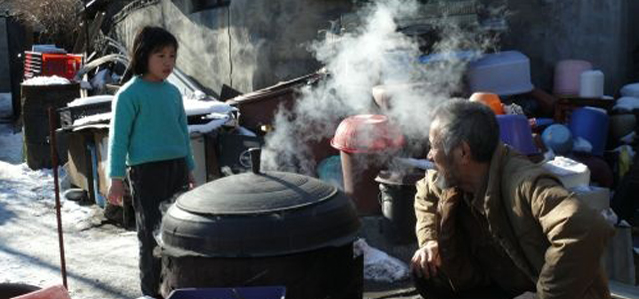
With a Girl of Black Soil
DS Then there is the rhythm of the wind flapping the flags. We see all kinds of flags. What do the flags mean?
JS It’s Tibetan culture — normally they are at the entrance to the villages or in the mountains, so that when people cross, they use the flags for praying; they might have teachings or verses written on them.
DS In Himalaya we follow the protagonist on his path from the opening of the film, yet how long does Himalaya carry on without the main character speaking? It seems to me, all the way from Korea to Katmandu, into the mountain, after he wakes up, and even after that. It seems at least twenty minutes before he speaks at all.
JS It’s about fifteen or twenty minutes.
DS Let’s talk about the rhythm of your editing. You use shot-sequences, often of a very long duration. Also, the camera seems to wait until the characters leave the frame. I never think of editing in your film. I only react to the surprise of an image. It seems you’re not using montage-style editing, but using editing for the surprise, the complete change.
JS Three things here: first, if you edit too much, especially within the scene, you lose the sense of the character’s inner journey; second, I like to create an observational stance for the scene, so that you feel like an observer watching; and third, I like to impart the feeling to the audience that they are going on the journey with that character.
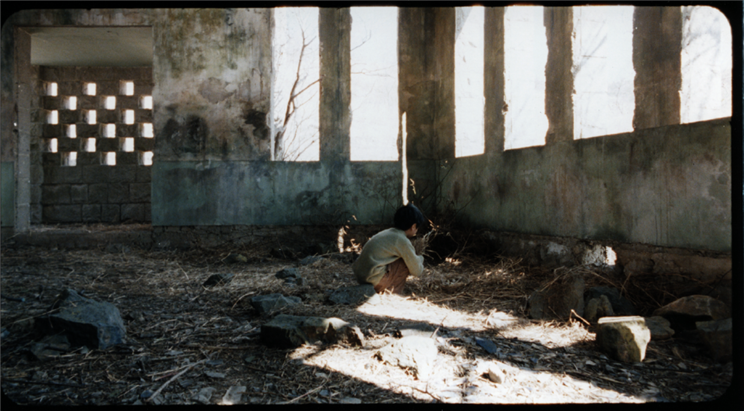
The Bird Who Stops in the Air
DS Yet you allow us to choose where to focus. As spectators, we have a distance in looking at something happening in front of us. You use lots of long shots – long camera distance – and very wide shots with a fixed camera position.
JS I want to give the audience a very truthful feeling, to be as faithful to life as possible.
DS So in this sense Himalaya, for example, looks more like a documentary, maybe not in the rigid definition of the word, but in the ethnographic sense. We’re observing the life of a culture, happening on its own terms, in its own way, without you interfering as a filmmaker.
JS On purpose I try not to impose anything on the cultural aspects of the movie so that it captures the truthfulness and the reality of the character in that situation.
DS What took you there? You went to Nepal as stranger; how did you get inside the people? How did you get to know them? Of course you use the art of cinema to bring it home, but are the people in your film actors? How did you work with them? And why did you film there, and not in Korea?
JS First of all, I was at a point in my life when I wanted to escape, in a way, from Korean society. Because of problems I was having with movies and financial issues, I basically just got on a plane and went to Katmandu, and being in that environment I heard of a village that seemed as if it would feel like the end of the world. Because I was in a certain state in my life, I wanted to go to an extreme place like that. So I went, and from there, visiting this place and interacting with the culture, the idea started. I went at the beginning because of personal problems and for personal reasons, but going there I was very moved by the people, their innocence, the way their spirits were living — I was really very moved by that.
DS Would such a story really happen? Is it more about you, or is it also about Korean society and Korean culture?
JS The story was a way to show a man overcoming his troubles through this journey, so that’s something that I personally experienced and that’s probably realistic.
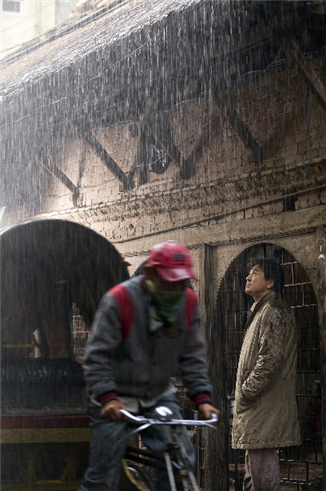
Himalaya, Where the Wind Dwells
DS Is the white horse a surreal image — the
motivation of the film, even the maker of the film?
I felt the soul of the horse as the protagonist and as the
filmmaker at once. It’s a little
magical; there’s no explanation for the horse there all alone; it just keeps moving through the film. And I couldn’t quite believe that a businessman would go all the way
from Korea
to this village to take those ashes.
There’s something wishful about it. How does it fit with Korean society today? JS There are a lot of Nepalese
immigrants working in Korea,
and since they're illegal, there are run-ins with the
police, and accidents occur. I'm
showing our responsibility, because the Nepalese worker
died in Korea, so we have culpability and guilt related to workplace accidents. Also the Korean man goes to Nepal for his
own purposes, so I used the white horse as the soul of the Nepalese worker who died. The horse guides the Korean man through
the Himalayas. So maybe the man on the journey will be cured by
the wife of the man who died.
There’s a scene in which the Korean man follows the horse into the valley and gets
sick, and the woman washes him and cures him.
DS Is the white horse an omen or a sign?
JS At first the man goes on this journey to cleanse himself of some inner problems, but also by following the white horse, he creates some external problems for himself; he becomes sick. And when he’s cured by the woman, in a way, she helps him overcome his troubles, so it’s a two-way thing — an internal journey and an external journey.
DS How important is the story itself to your filmmaking? You know in some cultures, or with other filmmakers, the narrative is all that matters. How important is it to you?
JS The way I approach the storytelling is to create a treatment of about twenty pages and then go location scouting, where I try to become the character and do the journey in these places. That’s where I find the images, the composition and the action within each shot, the kind of feeling I want to get across at that moment. I also think a lot about lighting, and how it gives a mood to a scene, and also the contrast. I have a preference for light coming in from the side. Then I slowly storyboard the film. So it’s not like I start with a scenario.
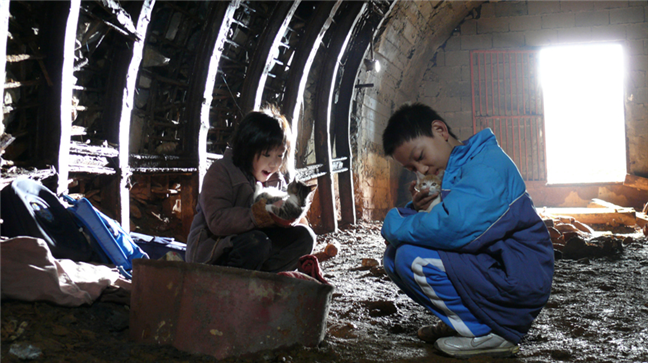
With a Girl of Black Soil
DS So you’re not writing a script?
JS No, not completely before making the film.
DS So first the treatment, then the locations, and then do you write a script?
JS Yes.
DS And that means what the people say, right? They’re learning lines? They’re not professional actors, are they, but lay actors, other than Choi Min-sik (Old Boy, Sympathy for Lady Vengeance) who plays the protagonist?
JS Only the Korean man is a professional; all the others — the mother, the boy, and the grandfather — are locals from that village.
DS Who is the lover?
JS Ever since the sixties it’s been a part of the culture that one woman can marry two brothers.
DS So the man who comes into the home is the brother of the man who died, and it’s totally legal. And it’s only the Korean man who doesn’t understand?
JS Yes. It’s the culture sometimes in the mountains, these days as well as in the past.
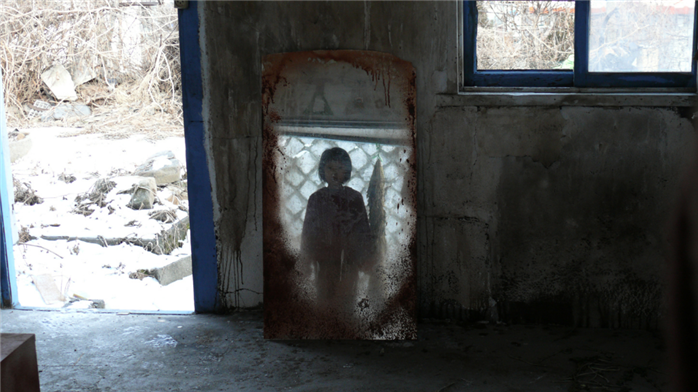
With a Girl of Black Soil
DS I noticed a credit for Abderrahmane Sissako, a very poetic, socially conscious African filmmaker from Mauritania, in the beginning of With a Girl of Black Soil. He’s one of my favorite auteurs. What is his relation to your film?
JS Sissako is a wonderful cineaste and director, someone who trusts me. He’s a companion, a co-producer. Sissako has been Co-President of our company, Dongnyuk Films.
DS Who is the cinematographer in your films? Is it the same person in each film? It looks like it.
JS My cinematographer, Kim Sung-tai, who studies in Lødz, Poland, worked with me on Himalaya, With a Girl of Black Soil, My Right to Ravage Myself, and my last movie, I Came from Busan.
DS You studied filmmaking in Pusan and Paris and then returned to Pusan, in the south of your country, to teach; but you grew up in the northeast corner of South Korea, and you’ve returned to that region to make several of your films, such as Time Between Dog and Wolf. What draws you there?
JS My home town is Sochko. My parents are from North Korea and there are a lot of displaced North Koreans who live in this region. I haven’t actually been back to my home town. It’s been about twenty years since I lived there, and returning to the area, about an hour and a half away where I shot my film, I felt a sense of displacement.
A lot of my films deal with trying to recover a sense of identity that one person has lost, especially in the film, Time between Dog and Wolf. About fifty percent of that film was shot in a coal mining town.
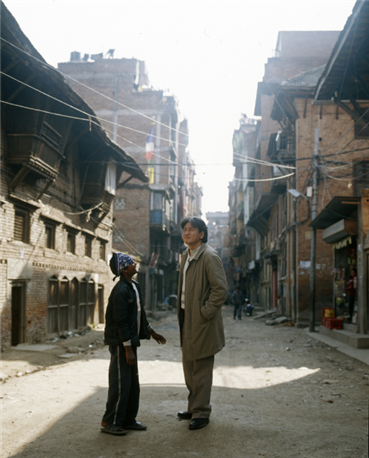
Himalaya, Where the Wind Dwells
While I was there I heard that miners who get black lung there can’t get treatment unless they have further complications or another kind of disease. So some of them make up diseases or try to get sick on purpose in order to get hospitalized or to get indemnity. This was the starting point for With a Girl of Black Soil.
One of the things I like to explore in my films is a sense of place and places disappearing — places from the past to which you return but can’t find again. A lot of the coal mining towns in Korea are disappearing or being destroyed by the rise of casinos, which creates a sense of loss for the people who’ve lived there.
DS Let’s talk about With a Girl of Black Soil, which has won such acclaim at festivals with critics and audiences alike. There you once again use lots of songs. Are they drinking songs of this region?
JS These are old songs with familiar melodies and the miners adapt them to their situation but keep the same rhythm. So I used the actual lyrics of the song as they were changed by the coal miners to express their struggles. In the restaurant where they sing it, they eat pork because of all the coal dust they breathe in as they work; they believe this meat cleanses the inside of their lungs.
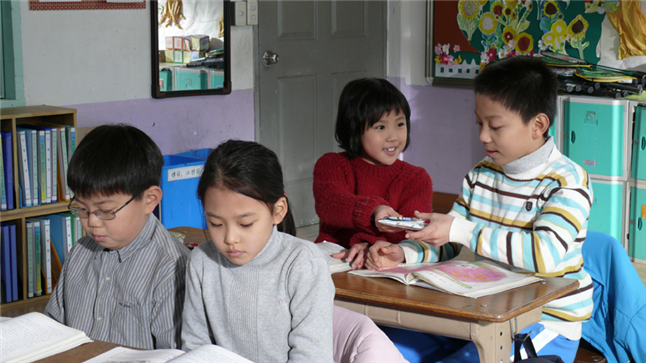
With a Girl of Black Soil
DS In your early films you used a small boy, but only briefly, in a kind of dreamy way. But in With a Girl of Black Soil, we could say that Yu Yun-mi actually plays the lead. What inspired writing this role?
JS When I researched the coal mining towns I noticed that a lot of mothers don’t live there — it happens that a lot of families are without mothers.
And I also observed that there are a lot of children playing around in these towns. More than creating some tragic conflict for this family, I wanted to focus on the young girl: I wanted to think of a situation in which a young girl would have to deal with some kind of tragedy, to see how she would live on through such an event, and to really give hope.
I think in a situation like this, the girl distinctly takes on mother-like qualities, partly for her brother. She knows that her brother needs to be in a special school, so she sends him there; and she knows what is needed to help her father, so she takes on the role of head of the family.
DS How did you determine the point of view in the film? Is it the child’s, the girl’s?
JS My main challenge in making With a Girl of Black Soil was deciding the directorial stance: whether to bring the audience very close in and be really intimate or to take a completely detached, objective point of view; but I found a middle ground where I could keep the perspective.
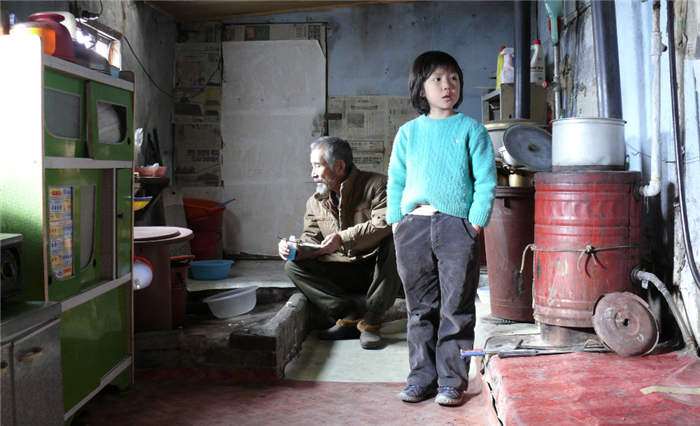
With a Girl of Black Soil
DS Are we supposed to be clear-minded about how the narrative ends?
JS It’s partly up to the audience. More important is what the young girl is thinking, what her intention has been. From her perspective, she’s been trying to help her father, her family as a whole. I wanted to end the film with the anxiety in the girl’s state of mind; she’s not really sure what will happen next.
DS You’re an Associate Professor of Cinema at Kyungsung University in Pusan. Is there something you’re telling your students over and over again as young filmmakers-to-be?
JS I want them to get in touch with their emotions and to develop their own sensibilities. So in the first class I ask the students to bring in a favorite poem and to take pictures, still photographs, conveying that poem, and then to turn them into a film. I believe in starting with the emotions, with the image, and developing it into the story. The most important thing I try to teach my students is to express their emotions directly, to make it personal.
Having said that, while the starting point for me has always been to try to tell personal stories, more and more, after making seven films now, I feel my themes and my perspective are getting broader and I want to explore different aspects of society as well. And then my last film, Himalaya, was also a co-production with France, so I think my horizons are broadening.
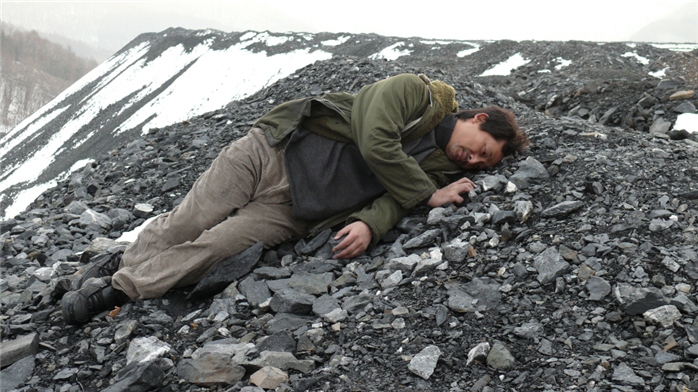
With a Girl of Black Soil
DS Do you have any favorite filmmakers who impress you?
JS These days I like the Portuguese filmmaker Pedro Costa, the Lithuanian Sarunas Bartas, and the Russian Alexander Sokurov. And before, Tarkovsky, Bresson, and Antonioni. I’m especially impressed by Three Days (Bartas) and Ossos (Costa).
DS When will we see your latest film, I Come from Busan?
It played at the San Sebastian International Film Festival; I’m waiting for one more festival before its release….
Himalaya, Where the Wind Dwells
Director: Jeon Soo-il; Producer: Jeon Soo-il; Screenplay: Jeon Soo-il; Cinematography: Kim Sung-tai; Music: Kim Hyung-suk; Editing: Kim In-soo, No Bong-seo; Design: Cho Yun-ah.
Cast: Choi Min-sik, Tsering Kipale Gurung, Tenjing Sherpa, Namgya Gurung, Hamo Gurung.
Color, 35mm, 95 minutes. In Korean, English and Nepali with English subtitles.
With a Girl of Black Soil
Director: Jeon Soo-il; Producer: Jo In-Suk; Screenplay: Jeon Soo-il, Jung Soon-yeoung; Cinematography: Kim Sung-tai; Music: Gae Soo-Jung; Editing: Suk Yong-Duk; Production Design: Lee Young-Hun; Costume Design: Nam Hyeok-Suk.
Cast: Ryu Yeon-mi, Jo Young-jin, Park Hyung-woo, Kang Soo-youn, Yim Jin-taik.
Color, 35mm, 87 minutes. In Korean with English subtitles.